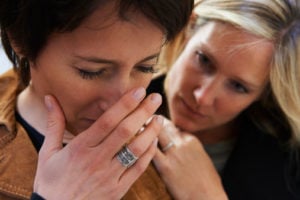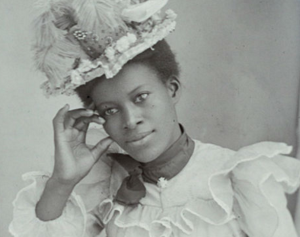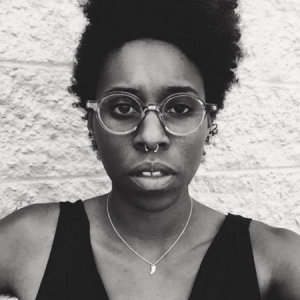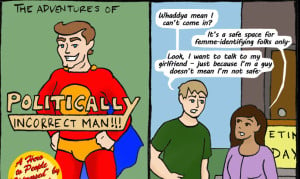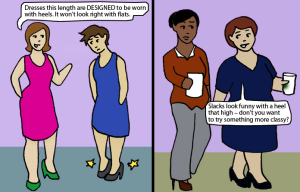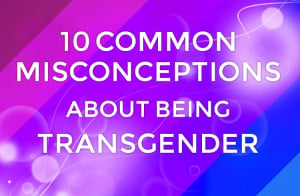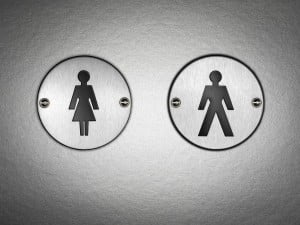
A young person with a somber expression in nature.
Structural racism is deadly – and not just because of police shootings of unarmed black youth.
Environmental racism – that is, the disproportionate exposure to climate change and toxicity that people of color experience – is a slower, more insidious form of violence against communities of color.
A fundamental proposition of climate justice is that those who are least responsible for climate change suffer its gravest consequences.
As such, here I’d like to explore concepts of environmental and social justice in order to examine issues of equality and human rights.
Wealthier nations bear the historical responsibility for climate change, with the United States at the top of the list. Climate change impacts vulnerable communities – most directly, women and people of color.
As feminists, we have a responsibility to recognize the interconnectivity between oppressions to do with race, gender, and environmental injustice.
1. Indigenous Communities Are at the Frontlines of Climate Change
Let’s talk for a moment about Alaska.
Alaska has warmed twice as fast as the global average, and this temperature change is only accelerating. Less sea ice covers the Arctic Ocean today than at any time in the recent geologic past. Permafrost (that is, permanently frozen subsoil) is responsible for keeping land intact and habitable along the Alaskan coast. The bad news: Alaskan permafrost is melting.
Flooding and erosion further damage and destroy infrastructure, directly impacting the livelihoods and homes of Alaskan residents. Indigenous communities are particularly hard hit. For many, community relocation is the only strategy that can protect them from the accelerating impacts of climate change.
The rub? Alaska is particularly vested in the fossil fuel industry, and that wealth is siphoned away from the Native Alaskan communities that it most directly harms and exploits.
In 2015, Alaska was the fourth largest producer of crude oil of all fifty US states. Over a third of all jobs in Alaska are tied to the petroleum industry. In light of the destruction of Native Alaskan communities that’s linked to climate catastrophe, what will it take to value people over profits? How far must this exploitation extend before we say no to an extractive economy?
The fact remains that indigenous communities suffer first. Displacement is a human rights violation because it destroys the cultural sustainability of communities that have existed in these places for thousands of years. It’s not only a loss of land, but also of cultural connection and history.
A similar set of questions is unraveling in North Dakota as the Standing Rock Sioux Tribe protests against the Dakota Access Pipeline.
The 30-inch diameter pipeline is proposed to stretch 1172 miles from North Dakota to Illinois, and would transport 470,000 barrels of crude oil a day. Proponents of the Dakota Access Pipeline (and other pipelines proposed or in construction) argue that pipelines help solidify US energy independence from unstable markets internationally. Every barrel that the domestic economy extracts and refines is a barrel that Americans don’t have to purchase from overseas.
The Standing Rock Sioux Tribe opposes the Dakota Access Pipeline for two reasons: 1) its route crosses burial places and sacred sites; and 2) if the pipeline ruptures, it would pollute the local drinking water supply, and that of millions of others who rely on the Missouri River.
Indigenous people are advocating in North Dakota to have ceremony, to call a place home, and to have an uncontaminated water supply.
Since early April 2016, protesters from various tribal nations (and allies from elsewhere) have occupied land at the edge of the Missouri and Cannonball Rivers on the Standing Rock Indian Reservation.
The protesters pray, sing, dance, prepare free meals, and share traditional skills like holding an Inipi. Representatives from over 200 tribal nations have arrived from as far afield as the Sami people from northern Norway and Sarayaku in Ecuador. This movement of Native solidarity across tribal boundaries is unprecedented. Recently, the first baby was born at the resistance camp, a cause for celebration.
#NoDAPL protests center on the idea of tribal sovereignty. The story of the Dakota Access Pipeline can be more fully understood in the context of tribal displacement in the United States.
Beginning with European colonization in the late 15th century, Native Americans have been killed and forcibly removed from their homeland, subject to land dispossession, oppression, and blatant racism. This human rights violation is nothing short of genocide.
An estimated Native American population of 10 million in 1492 dwindled to less than 300,000 by 1900. In the 2010 census, 5.2 million Americans self-identified as American Indian or Alaska Native. The legacy of colonial racism and violence lingers.
From 1778 to 1871, the US government signed and ratified 370 treaties with native tribes, many of which limited native lands to reservations. According to the treaties, tribes were to be treated as autonomous nations and dealt with diplomatically, like foreign governments, with an underlying relationship of trust.
These treaty rights are not honored. Unelected white agents from the Bureau of Indian Affairs ruled reservations and took measures to outlaw expressions of tribal language and religion.
US policies were structured around the desire to assimilate tribal peoples into the general population, rather than honoring and respecting their cultures. Starting in the 1870s, Native American children were forcibly removed from their families and sent to boarding schools, where they were prohibited from wearing traditional clothing and punished for speaking their languages.
In the 1950s, the Urban Relocation Program incentivized Native Americans to leave their reservations and move to cities. Promises for temporary housing, guidance in finding a job, and community resources weren’t always met. The relocated that did find a job often made little money. Separated from their families and familiar landscape, a sense of cultural separation set in. Many tribes are still recovering from these destructive policies of cultural termination.
Slowly, reservations have fought for and won back their treaty rights and their own sovereignty. The Army Corps of Engineers was required to consult the Standing Rock Sioux before permitting the pipeline, but tribal approval was not required to move forward with construction. If the cultural impact of the pipeline was considered seriously, there is no way that the pipeline construction could move forward.
The Dakota Access Pipeline must be viewed in light of a history of indigenous land displacement and disenfranchisement in the United States that extends backward as far as colonialism.
2. Communities of Color Experience Disproportionate Exposure to Toxicity
Race is the number one indicator for the placement of toxic facilities in the United States.
Evidence of this environmental racism came to light in the 1980s and 1990s, when Walter Fauntroy, a delegate for the District of Columbia and chair of the Congressional Black Caucus, tasked the Congress General Accounting Office with studying the location of hazardous waste landfills in proximity to communities of color.
The study, published 1983, found that three-quarters of hazardous waste landfill sites in eight southeastern states were located in poor, Black and Latinx communities. The strong correlation between race and the location of hazardous waste sites was the cumulative result of racist local, state, and federal land-use policies.
As the NAACP writes: “Environmental injustice is about people in Detroit, Ohio, Chicago, Memphis, Kansas City, and elsewhere who have died and others who are chronically ill due to exposure to toxins from coal fired power plants and other toxic facilities.”
Living in close proximity to toxic waste facilities isn’t just unfortunate; it’s deadly.
Climate change affects social and environmental determinants of health: clean air, safe drinking water, sufficient food, and secure shelter. Between 2030 and 2050, climate change is expected to cause approximately 250,000 additional deaths per year from malnutrition, malaria, diarrhea, and heat stress. What’s more, these deaths will not be distributed equally among people of all identities.
We need to reframe this issue to highlight its urgency. Climate change is an issue of life or death for vulnerable populations.
Taking action on climate change, especially from a place of privilege, requires empathy. Our lack of action in limiting catastrophic climate change suggests that, as a culture, we have an empathy problem – that rich lives matter more than poor lives, or that white lives matter more than Native and Black lives.
Unlimited economic growth is not the way forward – sustainability is.
Sustainability means valuing human life – all human life – as equal. Extractive industries are incompatible with this notion of racial equality. When it comes to proximity to toxicity, climate change is a life or death issue for communities of color.
3. Economic Inequality Intersects with Race and Gender
Who has access to resources to prevent and combat climate change, or the wealth to ignore its effects?
There’s a clear link between economic injustices and racial and gender injustices that manifests in how resources are distributed. Issues surrounding distribution of wealth – and the access of resources to leave unsafe areas – are highlighted by climate catastrophes.
Consider for a moment Hurricane Katrina, the category three storm that hit New Orleans on August 29, 2005. The Bush administration’s lackluster response to the crisis killed and displaced communities of color in New Orleans. Black communities were left behind with no evacuation plan and no urgent effort to rescue them.
Even ten years later, no one knows for certain how many people died as a result of Hurricane Katrina; estimates hover around 1000. The victims were disproportionately Black. In Orleans Parish, the mortality rate for Black adults was 1.7-4 times higher than the mortality rate for white adults.
Why? Income inequality is part of the answer.
At the time of the storm in 2005, New Orleans was one of the poorest cities in the United States: 28% of New Orleanians lived in poverty, over two times the national average. Of those poor, 84% were Black. These symptoms of structural inequality are the result of white supremacy and generations of racism.
The race-based wage gap is both structural and intersectional. While you might be familiar with the statistic that US women earn only 78 cents to the man’s dollar, the numbers are even more revealing when you break it down by race.
Compared to the white man’s dollar of earnings in the US, Latina women earn 54 cents, Black women earn 64 cents, and Native American women earn 65. For women globally, gendered wage inequality hovers around 15%.
What does economic injustice have to do with climate change? While both men and women are vulnerable in poverty, the prevalence of gender discrimination means that women are more limited in the resources they have to cope.
In extreme situations, such as the aftermath of a catastrophic drought or flood, women are the least likely to access education and healthcare, and are likely to be the last to eat. For women facing the impacts of climate change, the basic struggle to survive becomes direr in an already intense situation.
As the planet warms and climate catastrophes like hurricanes and droughts intensify, this existing inequality is thrown into sharper relief. We have to listen to the voices that are unheard, unrecognized, or otherwise silenced.
Again, climate change is a matter of life or death for marginalized communities.
4. Women in Communities of Color Carry the Burden of Intense Weather Events
In a time of climate crisis, the connection between race and gender-based inequalities is thrown into sharp relief.
Hurricane Matthew made landfall in Haiti on October 4, 2016, killing upwards of 800 people in its wake. Why was the storm so intense? Due to anthropogenic influence (read: burning fossil fuels), global sea surface temperatures are at their highest level since records began.
The ocean is responsible for absorbing over 90% of the extra heat generated by human activity. Not only does has this temperature impact the non-human world – prompting fish, sea turtles, jellyfish, and other species to change their habitats – warming oceans are also the engine behind super-strong hurricanes. Warmer waters fuel more energetic storms.
In a natural disaster such Hurricane Matthew, women are often the last to escape, as they prioritize the safety of their family and children. Women and girls are also more likely to experience sexual violence in the chaos that comes after the flooding.
Far from Haiti’s coasts, Syrian women are experiencing impacts of climate change in the context of political instability. From 2006-2011, a sustained drought in Syria led resulted in nearly a million rural villagers losing their livelihoods.
The drought, the most severe on record, was more intense and long-lasting than could be explained by natural variations in the weather; this was anthropogenic climate change (climate change caused by human activity) at work.
After losing their farms to drought, Syrian villagers migrated to cities, where water scarcity was also an issue. This massive population displacement from rural to urban areas, combined with a lack of jobs, fueled social unrest and a sustained revolutionary movement.
In this humanitarian crisis, women and girls are more at risk of facing sexual and gender-based violence due to a lack of social protection and safe access to services. Climate change fueled conflict and gender-based violence – specifically rape, assault, and intimate partner violence – go hand in hand.
And the communities who are hardest hit by the climate crisis are inevitably communities of color. Race and gender intersect along the axis of climate injustice.
5. Climate Displacement Is Happening Now
There exists a clear divide in power and resources between the Global North and the Global South.
The Global South includes nations in Africa, the Middle East, Central and Latin America, and most of Asia, where political and economic upheaval are prevalent, and markets are classified as emerging. The South includes 157 of a total of 184 recognized states in the world.
The Global North is the seat of traditional power, with North America, Europe, Australia, New Zealand, and industrialized parts of Asia at the helm. The North houses all the members of the G8 and four-fifths of the permanent members of the UN Security Council.
Nations in the Global North have contributed disproportionately to the carbon dioxide emissions that change climate, and yet nations in the South suffer the worst climate catastrophes.
Decision making power is concentrated in the hands of the most wealthy, and is not given to those who are the most vulnerable. Powerful and wealthy nations are the ones who most need to change their carbon-intensive habits.
For an example of this inequity, consider Tuvalu, a coral atoll nation in the Pacific and member of the Global South that is on track not to exist in the next fifty years due to sea level rise.
The highest point in Tuvalu is only four meters above sea level, and the sea level has been rising at a rate of four millimeters per year since the Australian government started monitoring it in the early 1990s.
While there once used to be a freshwater lens beneath the island, that water has since become salty and contaminated. All of the water for the country’s 10,000 residents comes from the rain.
Tuvalu has a relationship with governments of Fiji and New Zealand such that it’s easy for Tuvaluans to migrate out of the country. But they’re not just immigrants – they’re climate refugees.
Why is the migration situation in Tuvalu so harmful? For one, climate change calls into question the notion of home, homeland, and nation. Which communities are worth protecting and saving, and who are we (carbon-intensive climate destroyers of the Global North) to decide who survives?
As a white, middle-class woman from the United States, I am deeply uncomfortable with the existing hierarchy of nations, where the interests and needs of women and people of color are at the bottom of the totem pole.
What happens when entire homelands cease to exist? Climate migration. We are seeing the effects of this now. It’s not a future issue; it’s happening now.
This is the kind of change our generation is prompted to face. We have no choice but to do so. The world is waiting, and our time is running out.
***
How a society treats its gender minorities and people of color is often an indicator of how it treats its environment.
Climate change suffers a branding problem. What’s the big deal if the planet heats up a few degrees? Wouldn’t everyone love a little more summer? Isn’t it slow and relatively harmless?
In the words of Margaret Atwood, it’s better that we call it “everything change”
Changing the climate means altering weather patterns, which means changing rainfall, which impacts where humans can grow food. Humans require food and water and oxygen to survive. Climate change intimately alters the map of places we can call home.
Climate change is a problem that we were handed down from our parents and grandparents. I’m 24 years old, coming of age in this time of crisis. When I think about the environmental challenges that my generation faces, I think about the immediacy of how many humans there are living on the planet.
In high school, one of my teachers showed our class the global population curve. Never before have humans had to live with 7.3 billion others of our species. Living together requires managing the world food supply, energy capacity, and water resources in such a way that is equitable and sustainable.
The personal is political is ecological.
[do_widget id=’text-101′]
Devi Lockwood is a poet, touring cyclist, and storyteller from Boston. For the last two years, she has been riding her bicycle around the world to collect 1,001 stories about water and climate change (devi-lockwood.com). In November 2016, she’ll attend COP22, the UN talks on climate change, as a youth delegate with SustainUS.
Search our 3000+ articles!
Read our articles about:
Our online racial justice training
Used by hundreds of universities, non-profits, and businesses.
Click to learn more





